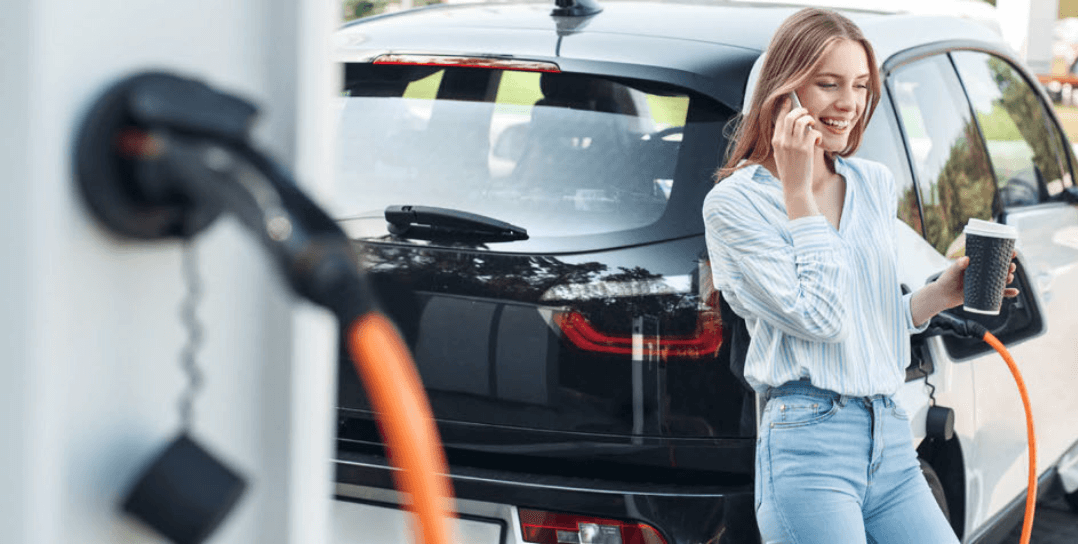Valuable information, tools and advice for you to view and download.
EV Myth Busting

Electric Vehicles
Addressing the myths to help you switch!
WHAT DO EVs REALLY HAVE TO OFFER?
With the introduction and growth of new fuel technologies, such as electric, it’s little wonder that many of us are left feeling confused about the choices available. To support you in deciding whether an electric vehicle (EV) is right for you, we’ve tackled the most common myths surrounding four key areas.
Watch out for our updates on social media.
Battery life
Charging points
Cost
Emissions
Battery life

Battery life
A common misconception about EVs is that the battery doesn’t last, making them an unsuitable option for longer journeys. Not only this, but it’s believed that charging an EV is time-consuming and impractical.
Range
The average real-life range of all EVs is around 190 miles. This means that long journeys are possible, you just need to plan for them.
Charge time
This depends on the speed of the charging unit and battery size, as well as the capability of the on-board charger (OBC). A home fast charger takes around 8-9 hours, so you can do this overnight.
Battery warranty
Battery life is determined by the EV make and model, as well as external conditions. New EVs normally have a battery warranty of at least eight years or up to 100,000 miles – whichever comes first.
Charging points

Charging points
Many people avoid choosing an EV due to the belief that they won't be able to travel very far because of the insufficient number of public charging points.
Public charging points
The number of charging points is increasing rapidly. These can be found at motorway service stations, supermarkets and retail outlets, as well as conventional fuel stations – some of which are free to use.
Home charging points
Charging your vehicle using a domestic charger can equate to a cost of as little as 4 pence per mile, compared to a typical 10-14 pence per mile fuel cost for a petrol or diesel vehicle (see here for more information). OZEV grants may also be available to help with installation costs, depending on your circumstances.
Payment
There are both small, regional networks and larger, national networks available for you to pay at public charging points. These can be accessed either via an app or a contactless payment card.
Cost

Cost
One of the biggest barriers people have when deciding whether to switch to an EV is that they're too expensive.
Running costs
Despite having a higher upfront cost compared to petrol and diesel cars, the running costs of an EV, such as road tax, service and maintenance, and fuel cost, are lower.
Cost per mile
Not all EVs are the same in terms of their cost per mile. As with petrol and diesel cars, it’s important to remember that this will be affected by not just the vehicle itself, but also the types of journey, driving style, load weight, temperature and weather.
Home charging points
The cost to charge an EV using a home charging point depends on your electricity tariff and the amount of electricity (kWh) used. Energy suppliers are also increasingly providing off-peak tariffs at lower costs to EV drivers.
Emissions

Emissions
Another question surrounding EVs is just how environmentally-friendly they really are.
Manufacturing
EVs have embedded CO2 in the manufacturing process prior to the CO2 that's emitted through production and fuel use when driving. However, this is roughly equal to that of petrol and diesel cars (excluding the battery).
Fuel use
Although the generation of EVs is not completely at zero emissions yet, both the production of petrol and diesel cars together with their fuel use far outweigh the CO2 generated from producing an EV battery.
Emissions
EVs have no tailpipe emissions, so are more environmentally-friendly compared to petrol and diesel cars. This also makes them a great choice for helping improve air quality in urban areas.
Frequently Asked Questions
Title
Where can I find reliable and impartial information about EVs?
www.ev-database.org – an independent website providing comprehensive information and data on every EV available, including both real-world and official data.
www.zap-map.com – the UK’s leading charging point website, providing both an interactive charge point map and general supporting information on EVs and charging.
Is it safe to drive an EV through standing water?
In an EV, the high voltage battery and electrical systems, such as the traction motor and inverter, are fully sealed and waterproof, so there’s no additional safety risk of driving through standing water compared to a petrol or diesel car.
What happens if I run out of electricity or break down in an EV?
As you near low battery levels, your car will alert you to this fact with obvious warning signs and graphics on the dashboard. Many EVs will also have the ability to direct you to the nearest charging point.
If you do run out of electricity, then you should treat this like any other breakdown and call your breakdown number.
Can I tow a caravan, horsebox or trailer in an EV?
In many ways, EVs are perfect for towing as they can produce maximum torque immediately, making it easier to pull away with a heavy load. The use of braking regeneration alongside conventional brakes means that an EV has greater ability and control to slow down with an additional load.
However, battery packs are very heavy, so EVs weigh much more than the equivalent petrol or diesel car, which significantly limits any potential towing weight capacity. The additional weight can also overload the electrical system during braking regeneration when slowing down or when driving down a steep hill.
Are EVs suitable for driving long distances?
Some top tips for long journeys include:
- Planning ahead for journeys that are beyond the range of your EV to avoid charging problems en route.
- Ensuring that you know what the real-life range of your EV is and that you also take into consideration the weather, load and type of driving.
- Working out how much extra range and electricity you need. This will tell you whether you need more than one stop.
- Planning any stops well under the range of your car in case of problems. You should be stopping around every two hours (100 miles), so use this time to charge.
- Stopping wherever possible at a location that has more than one charge unit to reduce the chance of a queue or broken charge point.
- Keeping your rapid charging between 20-80 per cent of the battery as either side of that will make the charging speed noticeably slower.
- Making the most of free fast chargers at supermarkets and retail outlets when you are parked up during the day.
